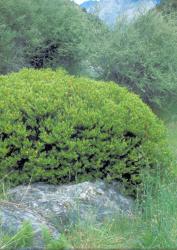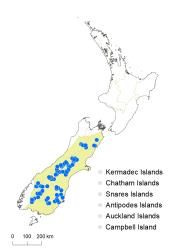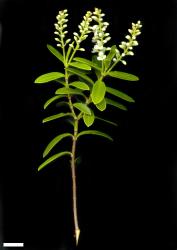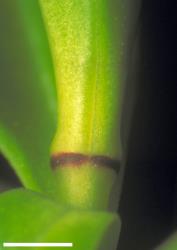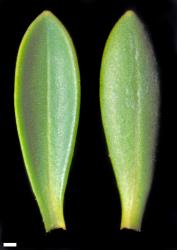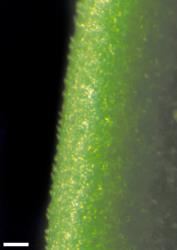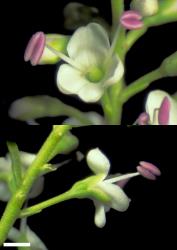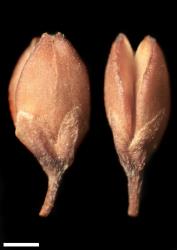- ≡ Hebe rakaiensis (J.B.Armstr.) Cockayne, Trans. New Zealand Inst. 60: 472 (1929)
- = Hebe scott-thomsonii Allan, Trans. Roy. Soc. New Zealand 69: 274 (1939)
Bushy, often rounded shrub to 2 m tall. Stems erect, eglandular-puberulent to -pubescent; hairs bifarious. Leaf bud distinct, its leaves appressed at margins until fully grown; sinus absent. Leaves opposite-decussate, erecto-patent to spreading; lamina sub-coriaceous, oblanceolate to obovate or elliptic, 6–20 mm (rarely to 30) long, 3–9 (rarely to 12) mm wide, glossy, pale to dark green above, pale green beneath, midrib evident; surfaces glabrous or usually with eglandular hairs along midrib above and rarely beneath; margin minutely ciliolate to minutely papillate, especially towards apex and when young, entire; apex sub-acute, obtuse, weakly plicate-acuminate; base cuneate; petiole indistinct, 1–3 mm long. Inflorescence a lateral raceme, 17–45 mm long; flowers crowded to somewhat distant, 12–48, female or bisexual on separate plants, ⚥ ≥ ♀; bracts alternate, ovate to elliptic, ≤ pedicels; pedicels erecto-patent to spreading, 0.5–4.5 mm long, eglandular-puberulent (rarely -pubescent) all around. Calyx lobes 4, obtuse to sub-acute, 1.0–1.8 mm long, sub-equal, mixed glandular- and eglandular-ciliolate. Corolla 3–6 mm diameter; tube white, 0.4–1.4 mm long, ≤ calyx, eglandular-hairy inside, sometimes with a few glandular hairs as well; lobes 4, white, erecto-patent to spreading or slightly recurved, unequal, obovate or elliptic, 2.5–3.0 mm long, obtuse to rounded or posterior sometimes emarginate; nectar guides absent. Stamen filaments white, 3–4 mm long; anthers pink to purplish. Style eglandular-hairy, sometimes sparsely, rarely glabrous, 2–4 mm long. Capsules latiseptate, obtuse to sub-acute, eglandular-puberulent, rarely -pubescent, 3.0–3.8 mm long, 1.9–2.1 mm at widest point. Seeds broadly ellipsoid, flattened, smooth, brown, 0.8–1.6 mm long.
V. rakaiensis plants are similar to those of several other species that are characterised by glossy green leaves, no bud sinus, and small, short-tubed flowers with rounded corolla lobes. The hairy ovaries and capsules distinguish it from most of these, except V. calcicola, which has leaves mostly > 20 mm long and glabrous corolla lobe margins. The corolla lobes of V. rakaiensis plants often have short to long hairs on the margins, a feature that is not seen in many other species.
V. subalpina plants have glabrous leaf margins, often fleshier leaves, and glabrous margins to the corolla lobes, corolla tube usually ≥ the calyx, often longer filaments and styles, and larger and glabrous capsules.
V. treadwellii plants differ in their glabrous leaf margins, larger flowers with longer corolla tube and lobes, longer styles, and larger, glabrous capsules.
V. traversii plants sometimes can look similar, but usually have narrower, paler leaves; their long corolla tubes, glabrous corolla lobes, and glabrous capsules distinguish them.
V. glaucophylla shares several character states with V. rakaiensis, but the plants differ in having glaucous leaves.
South Island: Marlborough, Westland (Nelson Lakes National Park and in the far south-east), Canterbury, Otago, Southland (on ranges and foothills east of the Main Divide). The northern limit (Hodder Valley) was accepted with some uncertainty by Bayly & Kellow (2006); the southern limits are at the Takitimu Mountains and Blue Mountains. It is absent from the Canterbury plains and has not been collected between the Waimakariri River and the Hanmer Springs region.
Sub-alpine and montane shrubland or scrub, and rock outcrops in gorges. Recorded elevations range from 525 to 1500 m.
There are records that might be hybrids with V. subalpina, discussed by Bayly & Kellow (2006).
Flowers: November–March; fruits: January–May (persisting until November).
2n = 80 (see Bayly & Kellow 2006, as Hebe rakaiensis).
Veronica rakaiensis is classified in V. subg. Pseudoveronica sect. Hebe and the informal group “Occlusae” (Albach & Meudt 2010; Bayly & Kellow 2006). ITS sequence data suggest a possible relationship with V. glaucophylla and V. pinguifolia, and its morphological similarities are with V. glaucophylla, V. subalpina, and V. treadwellii.
Leaf shape and size vary, with a geographical component (Bayly et al. 2001). Narrower, longer leaves are found in Otago and Southland. Some plants in Southland and South Otago have longer peduncles and longer hairs on the capsules.



